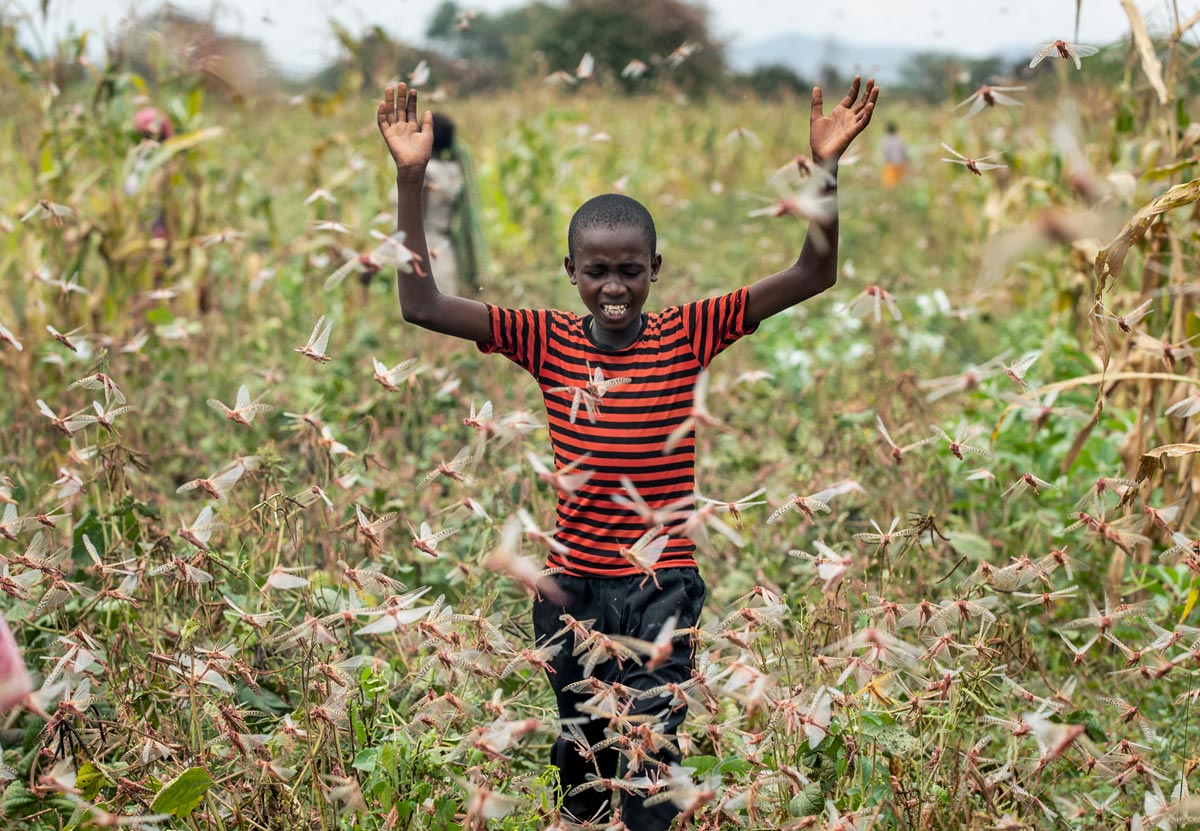Africa’s Swarm: The 21st Century’s Largest Infestation
Africa’s Swarm: The 21st Century’s Largest Infestation


Written for JESPIONNE

Topaz Jonez Goodall
East Africa is experiencing the largest locust infestation in 25 years, which began in Yemen in 2019, but has since migrated to Kenya. The Kenyan locust swarm is three times the size of New York City, equaling more than 172,973 acres and only growing larger. A closely approaching rainy season likely implies a second wave of new locusts, which will only add to the devastation caused by the current swarm.
Already at risk, Kenya’s food supply is now in danger. As need for food and other resources relating to the agriculture industry increase, the need to fend off these insects will grow. The COVID-19 pandemic has already stressed the under-equipped agricultural sector in Kenya and the surrounding countries, and aid for locust afflicted nations is scarce.



"W e must act immediately."
-Dr. Chimubu David Phiri
U.N. Food and Agriculture Organization of East Africa

March 2021

As food security decreases in the upcoming months, more complications will arise, and unrest will spread. Over 20 million individuals in East Africa are sensitive to food insecurity according to the United Nations Food and Agriculture Organization (FAO). Classified as the most destructive pest in the world, the desert locust swarm is up to 150 million insects per square kilometer dense, and just one swarm can eat the same amount of food 35,000 people can eat in a day.
Last January, the FAO requested 153 million dollars in aid to Djibouti, Eritrea, Ethiopia, Kenya, Somalia, South Sudan, Sudan, Uganda, Tanzania and Yemen to fund the resources needed to get rid of the locusts. FAO predicted the swarm multiplied close to 400 times by the end of that June.
Oxfam, a global organization working to end the injustice of poverty, works with local organizations in affected areas in north and eastern Kenya. Together, they are tracking the swarms and creating a plan on how to handle deploying aerial and ground pesticides.
Currently afflicted by disastrous floods, Kenyan roads are slowing response times to afflicted areas. The long-term effects of both the locust crisis and the flooding will likely reduce any education and infrastructure progress in the region. Some of the harshest conditions in the world, Kenya is undergoing great change due to both local and international pressure on the government to make improvements throughout the country.



The World Health Organization projects a 5% drop in Africa’s GDP due to the economic standstill brought on by the COVID-19 pandemic and the locust swarm. According to United Nations Economic Commission for Africa, as many as 20 million jobs will be lost.
Desert locusts are usually restricted to the semi-arid and arid deserts of Africa under normal circumstances. Locust numbers decrease because of natural deaths or through migration. This year has had higher levels of moisture in heightening the breeding conditions for desert locusts.
Intense rains, heat waves, and tropical cyclones have led to more unforeseeable swarms of
locusts, making it troublesome to prevent future outbreaks. Aerial sprays are the best way to combat this infestation, but COVID-19 set back a numerous initiatives to control the insect outbreak.
Even doing their part, NASA applied cameras and satellite data over the region to monitor environmental changes and their causes. This is not the end of Kenya’s fight against locust swarms, but the beginning. With new technology and proper care, Kenya’s path to agricultural success is made ever clearer. The only thing that can be done now is help to alleviate stress caused by food shortage.


Reference Article

By MATT SIMON for WIRED
As the Coronavirus pandemic exploded across the world earlier this year, another even more conspicuous plague was tearing through East Africa: locusts. The voracious little beasts are particularly fond of carbohydrates like grains, a staple of subsistence farmers across the continent. Back in January, the UN Food and Agriculture Organization (FAO) predicted the worst was still to come, and that by June, the size of the swarms could grow by a factor of 500. And now, at the worst time, a second wave of locusts 20 times bigger than the first has descended on the region, thanks to heavy rains late last month, according to the FAO. The swarms have infiltrated Yemen and firmly established themselves across the Persian Gulf, having laid eggs along 560 miles of Iran’s coastline. New swarms are particularly severe in Kenya, Ethiopia, and Somalia.
"The timing is really horrendous, because the farmers are just planting, and the seedlings are just coming up now since it's the beginning of the rainy season," says Keith Cressman, senior locust forecasting officer with the FAO. "And it's right at the same time when you have an increasing number of swarms in Kenya and in Ethiopia. There's already pictures and reports of the seedlings getting hammered by the swarms. So basically that's it for the farmers' crops."
This represents an unprecedented threat to food security and livelihoods,” FAO officials wrote in a brief last week. All this is happening while the region locks down to stave off the coronavirus pandemic, and as travel restrictions mean experts can't get to countries to train people. It’d be hard to imagine a more brutal confluence of factors.
Photos
Food and Agricultural Organization/ Tony Karumba/AFP/ AP Photo/Ben Curtis
TAGS
Kenya/ Yemen/ East Africa/ India/ Locusts/ Hunger/ Aid/ Disaster/ Farming/ FAO/ Middle East/ Pandemic/ Ethiopia/ Flood/ Coronavirus

March 2021





































